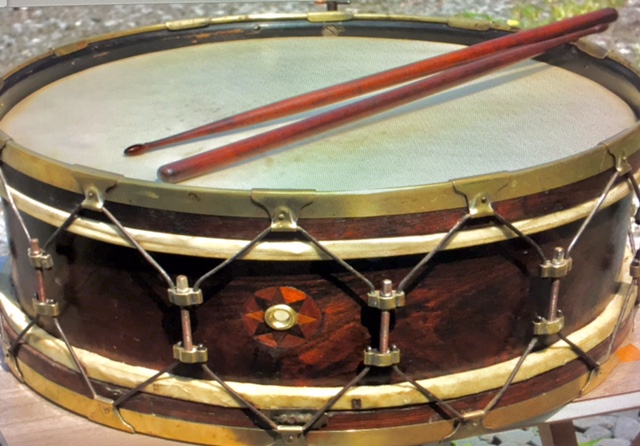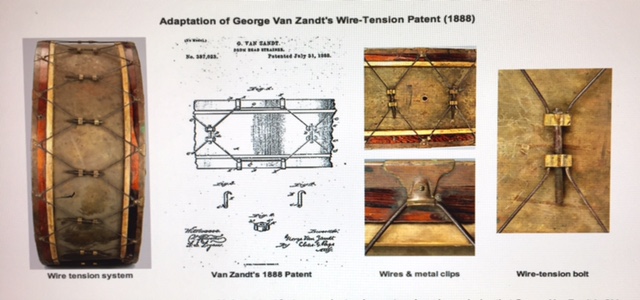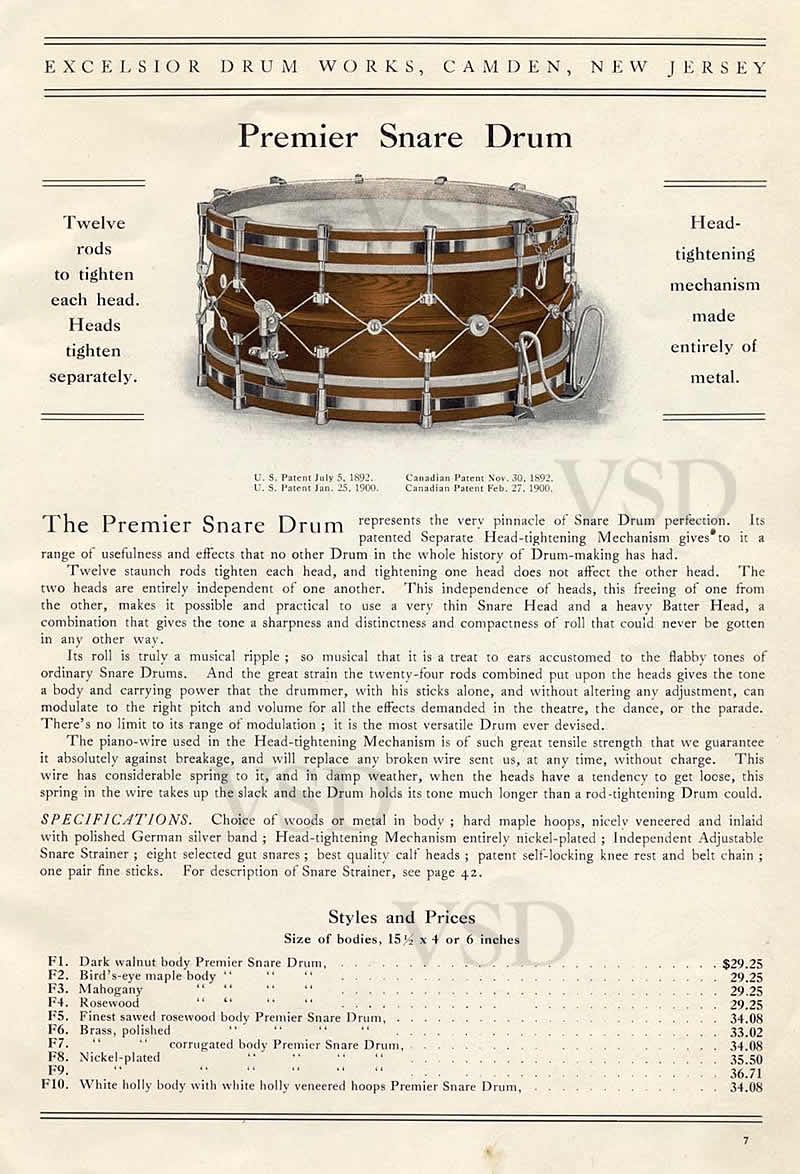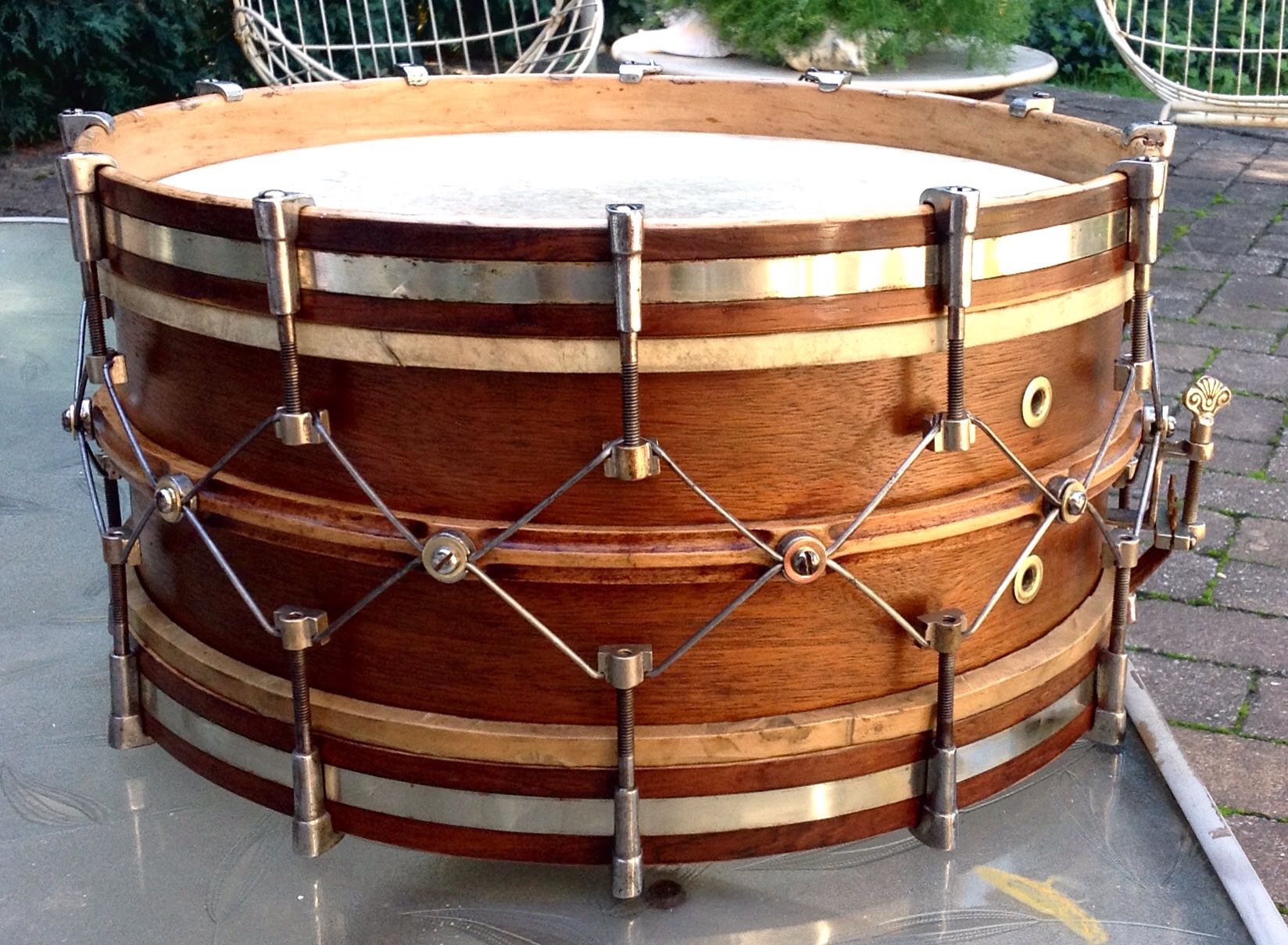The truss or wire tension drums were an evolution between the rope tension drum and the Prussian design drums of the time.
The late 1880s – 1900s was what was known as the “transition” period for snare drums and drums in general. This was the transition from rope tension to metal rod tension. It originated from the European or “Prussian“ designed drums consisting of sometimes highly decorated wood hoops over a metal shell. Metal hooks and long tension rods or bolts created single tension tuning between the top and bottom hoops.
During this “ Industrial Age” in America there were several drum companies in the larger cities of Philadelphia, Boston, Chicago and New York that were manufacturing these style drums. Labels applied inside Prussian drum shells usually list the retailer who sold the drum, but not necessarily the maker. Identical drums exist bearing differing labels thus the true origin of many drums is ambiguous. Shared catalog artwork between advertisers leaves the matter of determining a specific manufacturer even more dubious.
Prussian drums were sold by a vast number of music houses including John C. Church (Cincinnati), Oliver Ditson (Boston/New York), Lyon & Healy (Chicago), Thompson & Odell (Boston), J. W. Pepper (Philadelphia), Whaley & Royce (Toronto), John C. Haynes & Co. (Boston), the Rudolph Wurlitzer Company (Cincinnati), C. Bruno & Son (New York), and Julius Bauer & Company (Chicago). Even mail order companies such Sears Roebuck & Company cataloged Prussian drums among their selection of musical instruments.*1 This was true for the truss tension drums as well. Two of the companies known to create this tuning system and patent the design was George Van Zandt (1888) and the Excelsior drum company (1892) run by the Soistmann family in Philadelphia Pa./Camden NJ.. Sometimes these drums are known as J.W. Pepper drums as he was the sole distributor of these drums made by Adolph G. Soistmann of Excelsior.*2
The concepts of both of the manufacturers mentioned were basically the same with slight variation. Metal wire clips and tension rod receivers replacing the rope. The Van Sandt version had a metal rim folded over the top half of the wood hoops. Long flat hook shaped clips provided the tension points over the metal rim. The clips were fastened by one strand of wire running through the bottom that was connected to receivers on both sides. A square headed tension rod then ran through the top receiver down to a threaded opposing receiver, which then completed the entire single tension system on both sides of the drum. Like the rope tension there was no shell contact at all.
The Soistmann design incorporated many more parts and had shell contact and penetration. Each tension point included a slotted tension rod seated through a trunnion hook that then threaded into a receiver. Unlike the Van Sandt, a single piece of wire ran around the entire drum. It was bent and shaped to fit into slots of the receivers and into rounded shell. anchors that accepted both top and bottom wires at that point.
The shell anchors were fastened by a flat washer and a round head slotted screw that threaded into it to secure the top and bottom wire together. There was an external maple wooden reinforcement ring that was positioned on the outside center of the shell to support the anchors and accept the anchor through the shell. They were then fastened by a flat washer and square nut, which secured the entire system to the drum shell. This then completed the dual or separate tension of both top and bottom hoops.
Excelsior offered several wood finishes of Rosewood, Walnut, Mahogany and White Holly as well as metal which also had the center reinforcement maple ring. The hoops were nicely veneered in mahogany that was inlaid with highly polished German steel bands.*3
As for the snare throw and butt system, it was typical of its time with a slight twist. There were no snare throws to allow for on and off tensioning of the snare wires or gut cords of the time. A long thumb screw type bolt that had a flat decorative top screwed into a 2 piece receiver that clamped and held onto the open end of the gut cords. It was then tightened to the desired tension. The butt however was a bit ahead of its time as it allowed for separate tensioning of the cords. A small brass “L” shaped half box housed 4 “J” hooks that each had a threaded end. Each end had either a brass nut or threaded cap that allowed for separate finer increments of tensioning. One long strand of gut cords ran to and from each hook resulting in 8 snare cords on the snare side of the drum.
All in all counting the shell and 2 hoops and all of the finer bits and pieces this design required 122 parts the complete the drum. If the collapsible leg rest and belt chain for parade performance is counted then 124.
An interesting and innovative transitional system that would argue practicality while exemplifying the mechanical age of the American industrial revolution.
I knew nothing about these drums at all until it showed up on eBay US. It was so different and interesting looking to me that I was immediately drawn to it. It was completely present with original damage free parts and ORIGINAL HEADS!! But, in dirty dusty grimy condition. In my mind I saw it restored and knew it was going to be a celebrity. The seller acquired it at a live auction and had no back story of this amazing survivor.
After winning the auction, I contacted my vintage mates and got enough information to start me on my way to serious research of the maker, manufacturer etc. little did I expect the manufacturer and distributor to be based in Philadelphia and then Camden NJ. Both of these cities are literally 25 minutes south of my residence.
I found the wire design to be completely innovative and mystical that it peaked my interest and tugged at my mechanical heartstrings. The snare set up is surprisingly sensitive, changing the sound every 1/4 turn. The drum has the typical period field drum throaty dry sound and is happy at a certain tuning and tension that just reverberates your chest when it is strapped to the body and played. Due to the give of the calf head and looser tuning it requires some additional effort and technique to get the rudimentary style to be accurately performed.
I hope to acquire more of these elusive beauties that were present for only a moment in time. It represents a bridge from one tuning system to another and ironically looks the part as well with its exterior trusses.
Joe ( Joeyboom ) Mekler
1.) BostonDrumBuilders.com (blog) Sunday Oct.4, 2015
2.) Newsletter of the American Musical Instrument Society. Vol. XVI, No.1 Feb. 1987
3.) Excelsior Drum Works, Camden NJ Catalogue. Premier Snare Drum Page 7








